Find a Job You Really Want In
Research Summary. Whether you’re in one or not, you’ve likely heard about the importance of unions in the United States. Unions serve as a collective where fellow employees can protect each other and forward their interests.
But, what are some of the key differences between union vs. non-union jobs? We’ve investigated all the essential facts about the unions in the U.S., and according to our extensive research:
-
Only 11.6% of American workers belong to a union as of 2021.
-
Union members have median weekly earnings of $1,169, while non-union members have median weekly earnings of only $975.
-
There are currently 14 million private and public million union members across the U.S.
-
Between 1983 and 2021, the number of union members in the U.S. declined by 42.3%.

Union Membership Statistics by Demographics
Both men and women, as well as people across all races and ethnicities, can be a part of a union. However, not all demographics are represented evenly across U.S. unions. To find out more, we’ve gathered all of the most valuable facts and statistics:
-
Only 6.1% of private sector workers belong to a union.
That’s a whopping five times less than the percentage of public sector workers who are union members, which is a testament to how much pushback private companies have given to unionization.
-
Black Americans have the highest unionization rate, at 11.5%.
Comparably, 10.3% of White American workers, 7.7% of Asian workers, and 9% of Hispanic workers belong to a union. These differences can particularly be explained through a few factors, as specific demographics might work more private jobs than public jobs or have more union resources available to them.
Race % of workers who belong to a union White 10.3% Hispanic or Latino 9% Black 11.5% Asian 7.7% -
Women are nearly 35% more likely to be a part of a union.
As of 2020, 27.1% of women belonged to a union, while only 20.1% of men did. Interestingly, the percentage of female union members has remained stable for some time, but the percentage of male union members has dropped significantly from 35% in 1995.
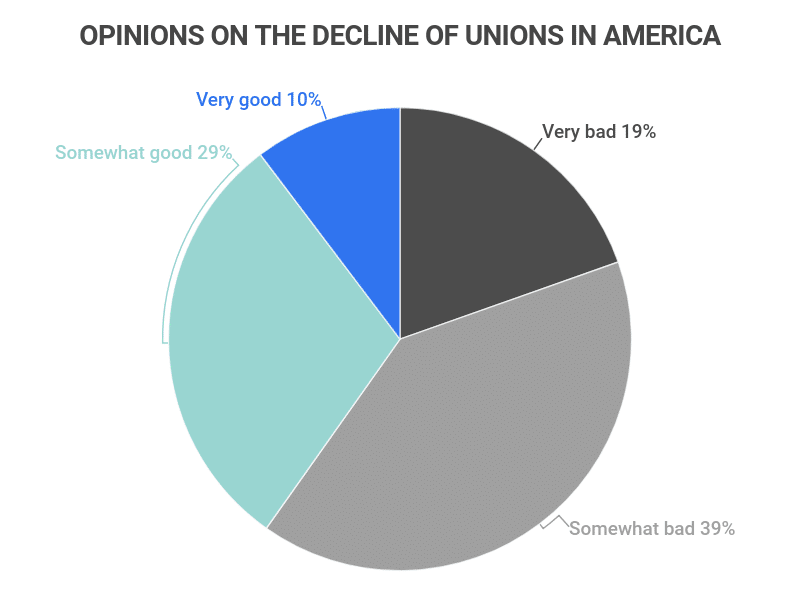
Union Membership Statistics by Industry
The industry you choose to work in will have a profound effect on whether or not you’ll have access to a union. Of course, the public sector on the federal, state, or local level will have the highest rates of unionization; however, there are other noteworthy industries as well. For example:
-
The industry with the most union members is Utilities, where 20.1% of workers belong to one.
Whether you get a private or public job in Utilities, you have a solid one-in-five chance of becoming a union member. Additionally, other industries with a high percentage of union members include: Transportation (16.7%), Telecommunications (15.4%), Educational Services (13.1%), and Construction (12.8%).
Industry % of workers who belong to a union Public Sector 33.9% Utilities 20.1% Transportation 16.7% Telecommunications 15.4% Educational Services 13.1% -
The industry with the least union members is Financial Activities, where 1.9% of workers belong to one.
Many industries in the U.S., especially ones with a high percentage of private workers, have incredibly low union representation.
For example, other industries with a low percentage of union members include: Leisure and Hospitality (2.2%), Wholesale & Retail Trade (4.5%), Mining, Quarrying & Oil & Gas Extraction (5.6%), and Manufacturing (8.5%).
Industry % of workers who belong to a union Financial Activities 1.9% Leisure and Hospitality 2.2% Wholesale & Retail Trade 4.5% Mining, Quarrying & Oil & Gas Extraction 5.6% Manufacturing 8.5% -
Iceland has the highest union membership rate at 91.4%.
Compared to the top ten countries with the highest rates of union membership, the U.S. has very low rates. For example, only one in ten Americans are union members, while nine in ten Icelanders are union members.
Country % of workers who belong to a union Iceland 91.4% Denmark 67.0% Sweden 65.2% Finland 58.8% Norway 50.4% Vietnam 49.6% Belgium 49.1% Kazakhstan 46.9% China 44.2% Malta 41.9%
Union Membership Statistics by Region
Not all U.S. states are created equal, and this is especially true for the number of workers who’re members of a union. For instance, our research shows that:
-
Hawaii has the highest percentage of union members, at 22.4%.
Nearly one-fifth of all Hawaiian workers are union members, but there are other states with high rates as well. For example, others among the top five union-friendly states include: New York (22.2%), Washington (19%), Oregon (17.8%), and New Jersey (16.2%).
State % of workers who belong to a union Hawaii 22.4% New York 22.2% Washington 19% Oregon 17.8% New Jersey 16.2% -
South Carolina has the lowest percentage of union members, at only 1.7%.
South Carolina is by far the most anti-union state, but there are others with low rates of union membership as well. For instance, North Carolina, Arkansas, Utah, and Texas all have union membership rates lower than 4%.
State % of workers who belong to a union South Carolina 1.7% North Carolina 2.6% Utah 3.5% Texas 3.8% Arkansas 3.9%
Union Membership Statistics by Top Benefits
Most Americans choose to join unions because of the benefits and protections offered by them. After all, unions can ensure they receive health insurance or that they aren’t unjustly fired. Overall, here are some of the top benefits of unions:
-
The average union worker is paid 11.2% higher wages than their non-union counterparts.
That might not seem like a lot, but if a non-union worker in the private sector earned $50,000 per year, that means a union member in the same line of work would earn an average of $56,000 per year.
-
Union members are 39% more likely to have health insurance.
While only 69% of non-union members are offered health insurance by their employer, union members enjoy health insurance as a nearly unanimous right, at 96%. Additionally, union members are also more likely to have paid sick leave, at a rate of 86% compared to 72% for non-union workers.

-
Union workers are 36X more likely to be offered a defined retirement plan.
Up to 79% of all union members have access to defined retirement plans, which can be a huge relief. It’s also a major difference between non-union workers, as only 17% of them are offered similar plans.
-
When union membership was highest in 1945, income inequality was 22.3% lower.
Union membership seems to strongly correlate with income inequality. For example, in 1945, union membership reached 33.4%, and the amount of wealth owned by the top 10% of Americans was 35.6%.
Flash forward to 2019, when only 10.3% of Americans were union members, and the fact is that wealth owned by the top 10% has risen to 45.8%.
Union Statistics by Public Opinion
Sure, there might be significant benefits to union membership, but how do Americans feel about unions? To understand how unions are perceived, here are some telling facts and statistics:
-
58% of Americans agree that declining union membership is bad for the U.S.
-
57% of U.S. Republicans see the decline of unions as a net good, while 40% see it as a net bad.
-
71% of U.S. Democrats see the decline of unions as a net bad, while only 27% see it as a net good.
-
69% of Americans ages 18-39 agree that the decline in unions has been a net bad for the U.S., while 61% between 40-64 and 61% between 65+ say the same.

-
65% of people with lower and middle incomes agree that the decline in unions has been a net bad, while only 56% of upper-income people say the same.
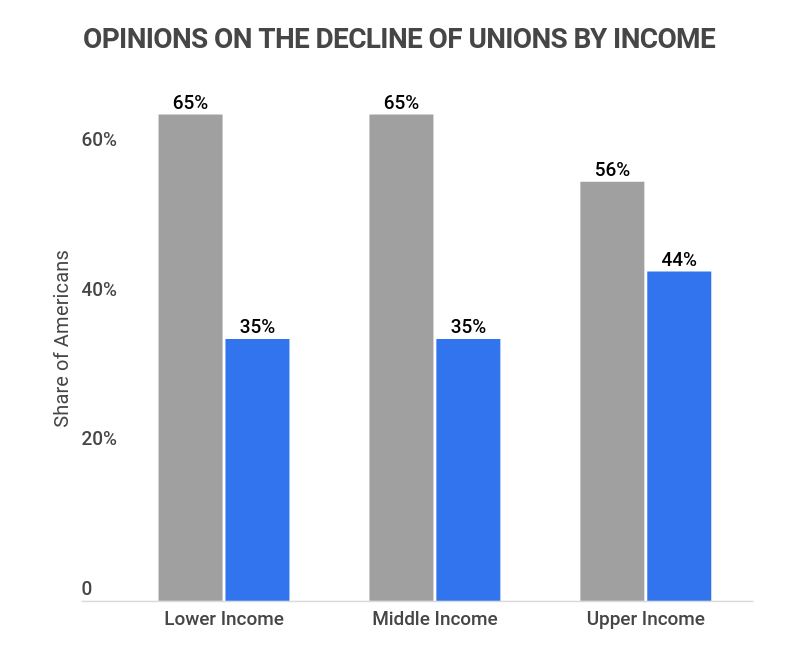
-
66% of Americans with college degrees agree that the decline in unions has been a net bad, while only 63% without degrees say the same.
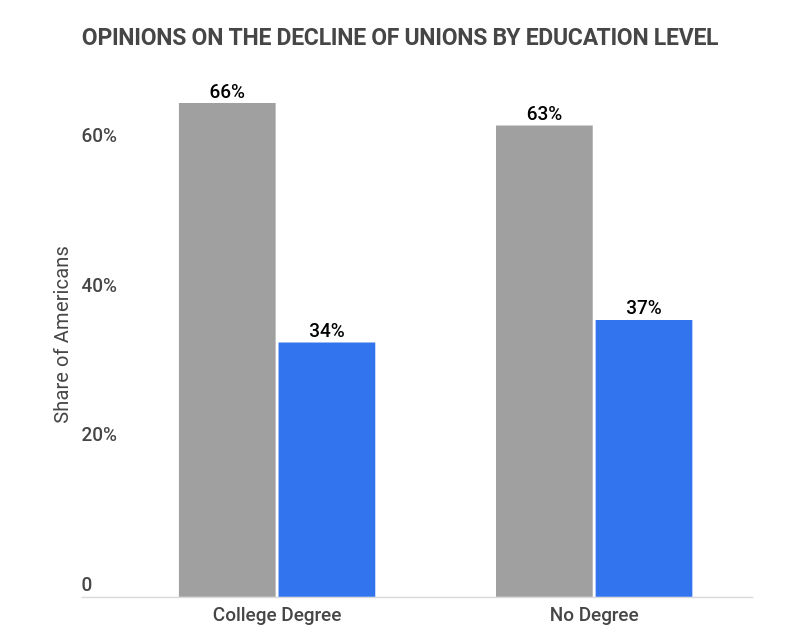
-
Black Americans see the decline in unions in the most negative light, with 71% agreeing it’s been a net bad for the country.
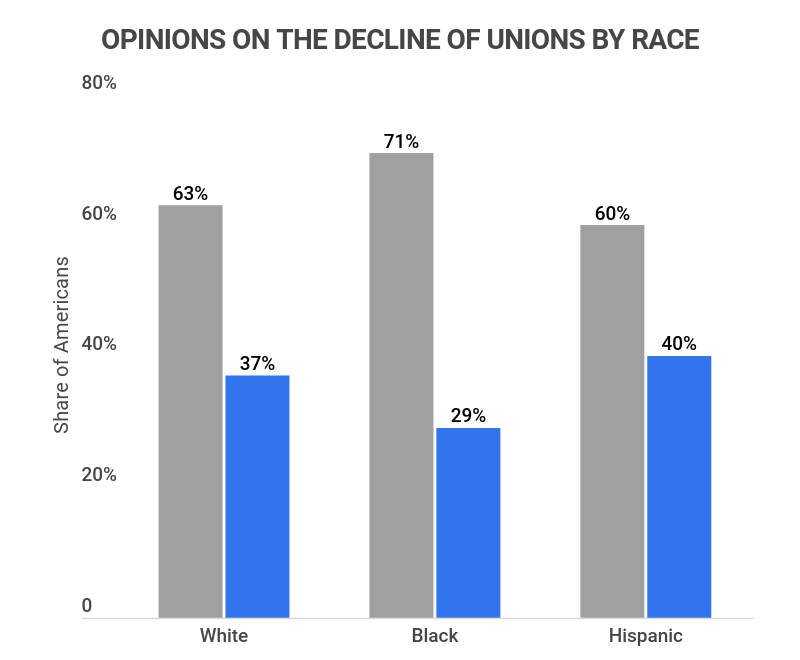
Union Membership Trends
It’s clear that union membership has declined for some time. However, what’s unclear is whether or not this trend will continue, as younger demographics are showing more interest in unions. According to our research:
-
Between 2020 and 2021, union membership rose by 7.4%.
In 2019, union membership reached an all-time low of 10.3%. However, since then, membership numbers have been slowly creeping up year-over-year. For example, between 2020-2021, union membership rose from 10.8% to 11.6%.
-
The last time union membership peaked was during the 2008 housing market crash, when it reached 12.4%.
While this certainly isn’t the highest percentage union membership has ever reached, it marked a noteworthy 3.3% increase from 2006 when union membership was declining.
-
Union membership reached its historical peak in 1945 when it reached 33.4%.
The U.S. has always had historically low union membership rates compared to other countries, even during peak years. However, years with high membership still marked a reduction in income inequality.
-
2020 saw the reduction of 9.56 million wage and salary workers, but only 321,000 union workers.
While union members did lose their jobs at the height of the COVID-19 pandemic, the fact is that they were far more protected than non-union workers. Even while the number of workers drastically decreased in the U.S., the percentage of union workers actually increased.
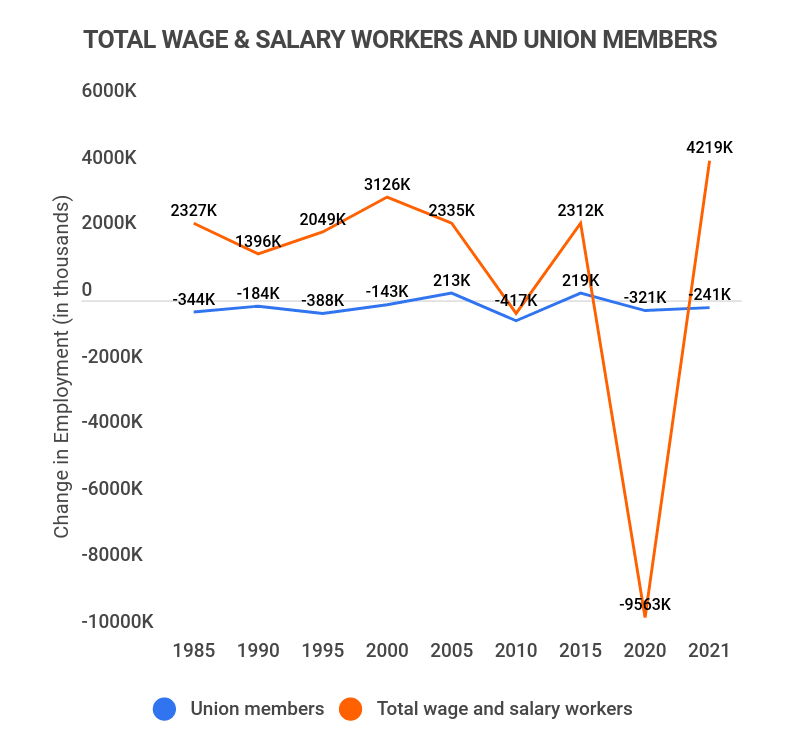
-
Between 2020-2021, union membership for Asian Americans decreased by 13.5%.
Decreasing from 8.9% to only 7.7%, Asian Americans lost more union members than any other race within the past year. However, this isn’t to say that other races haven’t also seen a decline in union membership. Black Americans also saw a considerable 6.5% decrease.
Race 2019 2020 2021 White 10.3% 10.7% 10.3% Hispanic or Latino 8.9% 9.8% 9% Black 11.2% 12.3% 11.5% Asian 8.8% 8.9% 7.7% -
U.S. Men are 7% more likely to be union members.
As of 2021, 10.6% of men are union members, compared to only 9.9% of women. This has been a trend for a while, with the gap between men and women remaining steady.
Union Statistics FAQ
-
What percentage of Americans are represented by a union?
Approximately 11.6% of Americans are represented by a union as of 2021. While this is an increase of 7.4% from 2020, when union membership was only 10.8%, it still marks a low point in U.S. history.
For example, during peak union membership in 1945, at least 33.4% of the total U.S. workforce were union members. That means that in less than 100 years, union membership in the U.S. has decreased by over 65%.
-
Is union membership increasing or decreasing?
Union membership is increasing slightly. However, it’s unclear whether or not this trend will last. Since the 2008 housing market crash, union membership decreased year-over-year from over 12% to just over 10%.
However, likely due to the COVID-19 pandemic and other economic factors, union membership once again saw an increase from 10.8% in 2020 to 11.6% in 2021.
-
What are the benefits of a union?
The main benefits of a union are protection and benefits. Union members are 39% more likely to have health insurance, 36X more likely to be offered a defined retirement plan, and get paid an average of 11.2% more than their non-union counterparts.
Less concretely, being a member of a union also comes with additional legal protection, meaning it’s much harder for your employer to fire you for an unjustified reason.
-
Why do companies dislike unions?
Companies don’t like unions because it gives employees more power. Seeing as a company’s main goal is usually increasing profits, unions are often viewed as standing in the way of that goal.
For example, if employees unionize and say they will go on strike if the company’s wages aren’t increased, this puts the company between a rock and a hard place. Either the company will agree and lose profits from the increased wages, or disagree and lose all of their employees.
Situations like this are why many major corporations dislike unions.
Conclusion
Unions play a crucial role in providing workers with power in the workplace, but membership has been decreasing for some time. Today, there are 65% fewer union members than there were in 1945.
This is despite the fact that union members are 39% more likely to have health insurance, 36X more likely to be offered a defined retirement plan, and get paid an average of 11.2% more than their non-union counterparts.
However, the tides may be shifting once again, as union membership increased by 7.4% between 2020-2021, and more and more young people are favoring unions.
References:
-
BLS. “Union Members — 2021.” Accessed on July 12th, 2022.
-
BLS. “A look at union membership rates across industries in 2020.” Accessed on July 13th, 2022.
-
ILO. “Statistics on union membership.” Accessed on July 13th, 2022.
-
ALF-CIO. “Union Facts: The Value of Collective Voice.” Accessed on July 14th, 2022.
-
BLS. “Union workers more likely than nonunion workers to have retirement benefits in 2019.” Accessed on July 13th, 2022.
-
EPI. “Unions help reduce disparities and strengthen our democracy.” Accessed on July 13th, 2022.
-
Pew Research Center. “Majorities of adults see decline of union membership as bad for the U.S. and working people.” Accessed on July 13th, 2022.
-
BLS. “Union membership rate declines in 2021, returns to 2019 rate of 10.3 percent.” Accessed on July 13th, 2022.





